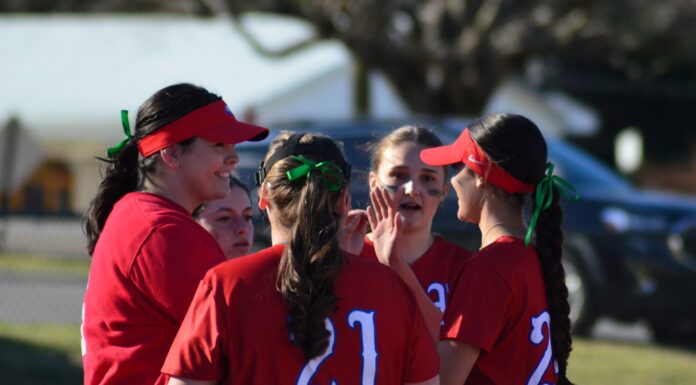
The Cullman Tribune is celebrating the Alabama Bicentennial (1819-2019) with statewide field reporting by Alabama Master Gardener/Botanical Artist Ben Johnson South. This year-long feature, “The 67-County Alabama Garden Party,” will spotlight different counties each week. Each county will get its own “quilt block,” along with a historical profile, and we’ll share a recipe specific to the area. At the end of the year, all 67 counties will be put in a book to commemorate the Bicentennial.
Cullman County
I’m writing this as a love letter to PLANTS + PEOPLE + a PLACE, Cullman County, Alabama, that I have loved all my long life.
Anything can grow and thrive in Cullman County. It is year-after-year, “the no. 1 agricultural county in Alabama” in many categories. This part of a great farm and garden state is an Eden where even a novice can plant strawberries and sweet potatoes at dusk and begin truck farming at dawn.
Cullman’s agricultural roots were established by German farm families in the 1870s who were seeking a more peaceful way of life. From the very beginning this has been a plant-centric place where bountiful crops provide the base for a flourishing economy and hundreds of home and public gardens offer armloads of prize-winning fruits, vegetables and blossoms.
After my dad graduated from college, his first schoolmaster assignment was in Cullman County’s aptly named Grandview area. This grandly beautiful part of Alabama grows acres and acres of the sweetest sweet potatoes in the nation, probably in the entire known world.
The French flog the superiority of their wines based on what they call the “terroir,” meaning “the land.” It’s the soil in Grandview and the entire county combined with the perfect climate that makes for such verifiably grand vegetable farming. Cullman County is in the Appalachian Highlands foothills, blessed with nutrient-rich soil and extraordinary botanical and animal diversity.
Later, we moved across the county to the Fairview area, specifically Baileyton. You could imagine the first settlers coming to this part of Cullman County, looking out at the promising, fertile vistas and exclaiming it “fair” indeed.
In this part of Cullman County, mama had a flower garden and daddy had a vegetable patch, but there wasn’t much lawn to mow because cotton grew right up to our front door. And we picked it. At that time in my life, all of us country kids got out of school each fall for two cotton-picking weeks. It wasn’t a fall break. Everybody and their brother, and their mama and their daddy, picked cotton.
Cullman County has also been Alabama’s “strawberry basket” with fields of sweet, red fruits stretching into the horizon. The Strawberry Festival still attracts thousands each spring to taste some lip-smackin’ fresh strawberry treats and hear some foot-tappin’ music. One of the most-popular music groups around here for decades has been The Strawberry Pickers, which Cullman-residing political giant, Governor Big Jim Folsom, “The Farmers’ Friend,” carried throughout the state to sweeten his campaigns.
My family stayed rooted to Cullman County and I am today; however, from Grandview then to Fairview my father’s work took us ultimately to a view of God in Alabama’s most-revered prayer garden at the Ave Maria Grotto.
“Little Jerusalem” as the 4.5-acre work of folk art and passion, the Ave Maria Grotto, is known, was part of the campus of St. Bernard College. Here, dad welcomed a return to his own passion, the serious study and teaching of philosophy. As a wide-eyed 5-year-old, I welcomed being a happy wanderer in Brother Joseph’s magical, sanctuary garden.
“GOD WOOS US IN GARDENS,” is a line I wrote in my journal one afternoon a couple of years ago at the Ave Maria Grotto. Regardless of how you may connect with the universe, or view a mysterious higher power, it’s evident in the beauty of a garden there is something out there bigger than you and I.
When I tour visiting friends through the Ave Maria Grotto prayer garden, I begin by telling them how the Bavarian-born, humble Benedictine monk, Brother Joseph Zoettl, who created it, had fervently prayed for years that he would be chosen to be a priest, a teacher. It was determined by the higher authorities at the Abbey that shy, homely Brother Joseph, who was neither physically nor intellectually commanding, was not suited to become a priest.
A priest regularly teaches 20 or 30 students each school year. But, for decades, beginning in the 1930s, tens of thousands have come each year to study the spiritual works and restore their own spirits in the prayer garden Brother Joseph envisioned and created. Here in a calm corner of Cullman County is a remarkable outdoor classroom nestled among the rolling hills covered by a canopy of trees and carpeted with a variety of vines exalting all kinds of evergreens and flowering shrubs. This exquisite sanctuary garden magically morphs into a great, green cathedral in spring and summer.
Sanctuary gardens for solace and meditation have become passionately desired in 21st century America, especially since the murderous, religious attacks of Sept. 11, 2001. When weary pilgrims come to the spiritual retreats at St. Bernard Abbey and nearby Sacred Heart Convent, they are often eager to replicate elements of the peace-filled, restorative feeling of the Ave Maria Grotto gardens.
LESSONS FROM BROTHER JOSEPH TO CREATE A SANCTUARY GARDEN:
*RETREAT FROM MODERN CACOPHONY- Plan for a private, outdoor space where you are removed from the “busy-ness” of daily hustle and bustle and can become mindful in nature. Strive for timeless surroundings devoid of objects or furniture which were mass-manufactured in your own lifetime. The Ave Maria Grotto is contiguous to the campus of St. Bernard but feels apart because it was carved from a deep ravine and has many trees and shrubs forming a sort of natural wall from so-called civilization. There are natural stone benches and sitting walls made from this quarried area.
*DESIGN FOR PEACE AND QUIET- A thick hedge muffles sound outdoors. Pea gravel walks slow the pace and can be quieter than cement or plank paths. If you live in a busy metro area, your sanctuary garden may be more achievable indoors with plants like palms and ferns and the contained trickle of a tabletop fountain. Brother Joseph sculpted hundreds of small, plant-punctuated “grottoes” and prayer shrines. Often these were sold to raise funds to support his work at the Ave Maria Grotto. Some of these original works may be affordable and obtained online. Or, start collecting bits of colored tiles, cosmetic jewelry and other googaws to sculpt your own spiritual objects.
*MAKE IT PERSONAL- The Ave Maria Grotto is a unique and particular expression of joy and adoration from one impassioned individual to the heavens. Your sanctuary garden should reflect your personal walk with nature, your journey. What are plants you cherish from your memories? Perhaps there is a motto or phrase you find bolsters your positive spirit. I commissioned talented Cullman-based muralist, Jack Tupper, to paint a weather-resistant plaque with the words: “God woos us in gardens.” It reminds me that I am connected to the universe and to God.
*ALLOW FOR GENTLE SOUNDS- A murmuring fountain can be ideal in a meditation garden. A tinkle of wind chimes sounds like prayers being lifted into the skies.
*ENGAGE NATURE- Few things are more soul-soaring than birds and butterflies in a garden. Select plants that attract and nourish the particular kinds of wildlife that enchant you. We need more beneficial, pollinator insects like bumble bees and butterflies in America. You can add value to the natural world by planting the nectar plants these creatures savor.
*LET GARDENING RESTORE BALANCE IN YOUR LIFE- Accept that gardens are about change. Your sanctuary garden will not be completed in a weekend. In fact, like all things and people, it will never be fixed in time. Slow yourself and breathe in the restorative, open air. The Ave Maria Grotto has survived decades of storms, major tornadoes, drought and even brutal blizzards. But, each season, it creates newness, hope, calm and beauty.
Thoreau went to Walden Pond to reflect and reconnect to nature. Throngs come to Brother Joseph’s inspiring garden at the Ave Maria Grotto in Cullman, Alabama. And, with only a bit of soul-searching and a spade, you could create your own sanctuary garden to offer peace and solace just outside your door.
Here are other positive and pleasurable ways PLANTS + PEOPLE connect in this part of Alabama, including the recipe we plan to offer at the 2020 Strawberry Festival in Cullman:
*FESTHALLE MARKET PLATZ- This unique farmers’ market is a recreation of a large, open-air German market and is one of the most popular spots to gather in town; located at 209 First Ave. NE, Cullman, AL 35055; Tuesdays, Thursdays, Saturdays 7 a.m.-2 p.m., early April-late October
*HANCEVILLE FARMERS’ MARKET- 200 Bangor Ave., Hanceville, AL 35077; Wednesdays, Fridays, Saturdays 7 a.m.-2 p.m., April-December
*CULLMAN COUNTY FARMSTANDS- Bagwell Blueberry Farm (Cullman), Chambers Farm (Holly Pond), J. Calvert (Cullman), Jeffrey James (Hanceville), John Sumner (Crane Hill), Lawrence Calvert (Cullman), Steele Orchards (West Point), Sweatmon’s (Crane Hill), Doug Spradlin (Vinemont), William Burks (Fairview)
*CULLMAN COUNTY PLANTS ADVICE/EDUCATION- Alabama Cooperative Extension System, 402 Arnold St. NE, Suite G-1, Cullman County Office Building, Cullman, AL 35055, 256-737-9386
*NORTH ALABAMA AGRIPLEX- Its mission is to educate and promote north Alabama agriculture and future sustainability; 1714 Tally Ho St. NW, Cullman, AL 35055, 256-297-1044; www.agriplex.org
*THE SHRINE OF THE MOST BLESSED SACREMENT- A 400-acre Roman Catholic Latin Rite Shrine known for its gilded church interior and the solemnity of the cloistered monastery; many pilgrims express amazement viewing this late-20th century creation which resembles an ancient, Italian village rising in the Alabama countryside. It is affiliated with the Eternal Word Television Network and is operated by the Birmingham, Alabama Catholic diocese; garden enthusiasts will especially appreciate the Lourdes Grotto. www.olamshrine.org
*PLANTING AN IDEA- A 2010 study in The Journal of Health Psychiatry verifies what many of us already know- “gardening reduces stress.” Furthermore, a recent Harvard University study concludes that people who live near plants and vegetation live longer and have lower levels of depression. Cullman County can lead the way to show how overly anxious, 21st century Americans can improve their mental as well as physical health by experiencing sanctuary gardens like the famous one at the Ave Maria Grotto and also by creating their own spiritual healing gardens.
Y’ALL COME to Cullman County on your 67-County, Alabama Garden Party tour, where you’ll get sweet strawberries to feed your hunger and sweet inspiration and peaceful sanctuary.
MANY THANKS to Tony Glover, coordinator for the Cullman County office of the Alabama Cooperative Extension System. Tony is one of Alabama’s most knowledgeable and contributing plantsmen and has been a tremendous support to this year-long exploration of PLANTS + PEOPLE across our state. Also, THANK YOU to Laurie Johnson, who has created dozens of imaginative and delicious recipes for this series to celebrate botanicals throughout Alabama.
Cullman County Strawberry Creams with Thyme and Lemon
There may be hundreds of ways to enjoy fresh strawberries, but this simple recipe truly makes the berry the star of the show. Enjoy them well-chilled so the cream filling will be firm.
Ingredients:
- One large carton of fresh strawberries, rinsed and patted dry – about 20
- One 8 oz. container of cream cheese
- One 16 oz. box or bag of confectioner’s sugar
- Zest from one lemon
- 8 fresh thyme twigs – with small leaves stripped and minced and stems discarded – plus a couple more twigs for garnish
Instructions:
- Prep strawberries – Cut off the tops of the berries, retaining some red parts and the green stems (if they are pretty) and set aside. Gently hollow out the insides of the berries and discard pulp.
- Cream together the cream cheese, sugar and lemon zest until well mixed. By hand, stir in the minced thyme.
- Put cream cheese mixture into a piping bag or a plastic storage bag with the corner clipped off. You might need to refrigerate it for the mixture to become firmer before piping it into the hollowed-out berries to about a 1/4 inch above the top of the berry. You can nestle them into a mini muffin pan to help them stay upright.
- Place the reserved berry tops back on and chill for several hours. Garnish with thyme and enjoy this fresh, but sweet bite that truly makes the berry the star of the show.
Also, check out Alabama Bicentennial: 200 ways to save Alabama for the next 200 years.
Copyright 2019 Humble Roots, LLC. All Rights Reserved.
























